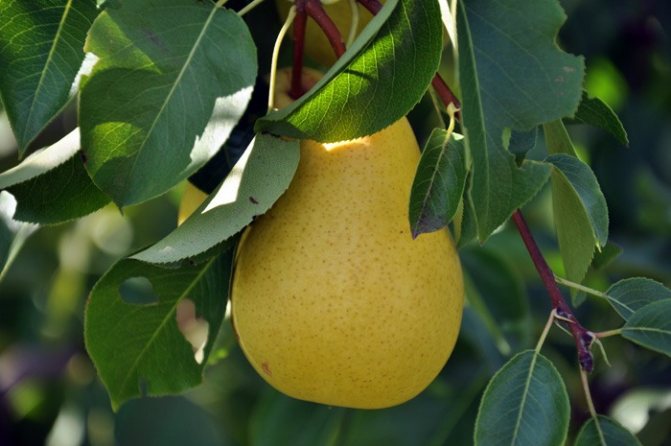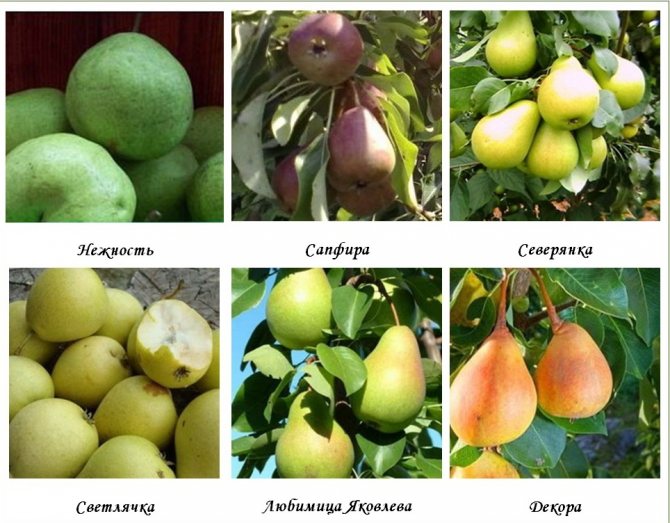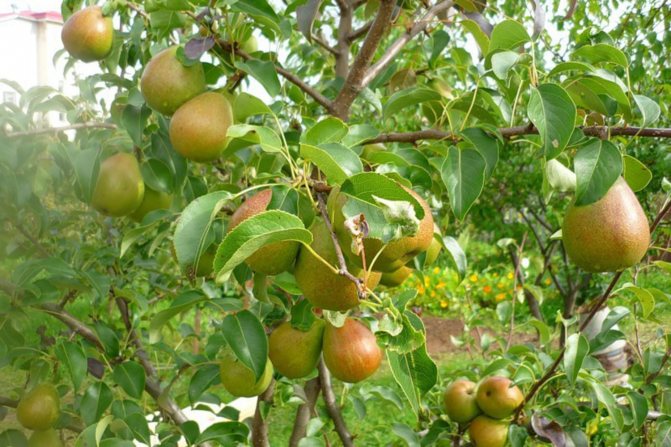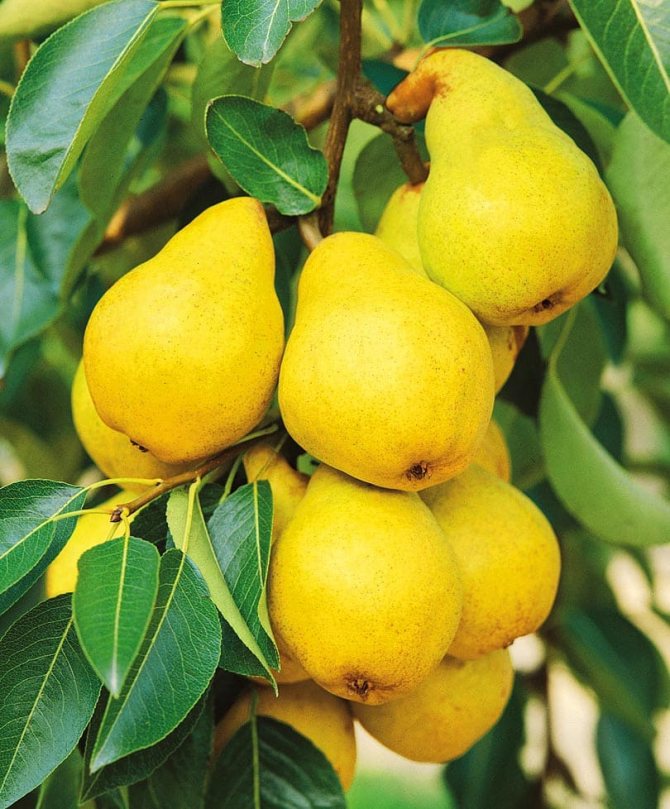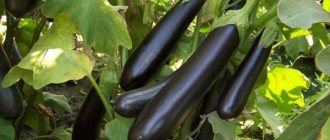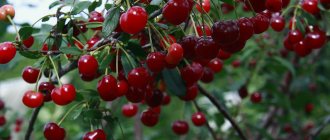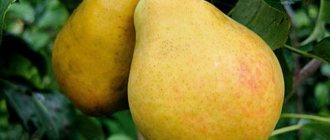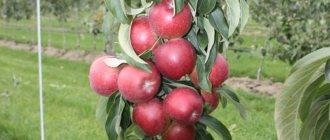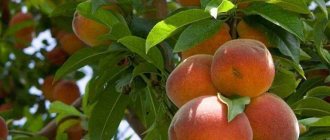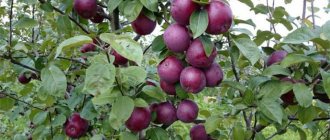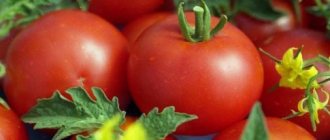Some consider this fruit tree to be unproductive. However, among those gardeners who love to grow new varieties, and who appreciate every square meter of land, the columnar pear has long become popular. With proper care, its yield per hectare is three times higher than that of classic pears. And harvesting its fruits is much easier. This "inch" has its own requirements for planting and cultivation. All of them are easy to do. So planting at least a couple of such fruit trees on your site will be useful and interesting to everyone.

Description
The breeder Kachalkin bred the columnar pear as a dwarf species. Therefore, her dimensions are really miniature. However, the tree can stretch up to 2.5 meters in height. The trunk of columnar pears looks no different from the usual one, but it is somewhat thicker and almost always even, not branched. Some people think that the columnar pear grows without branches. This is not true. She also has branches, only they never form a lush spreading crown. Fruits are almost not formed on them, mainly only on small fruit branches growing on the trunk itself. Leaves and flowers in columnar varieties are common, pears are large and juicy. These fruit trees begin to bear fruit early, already in the second year after planting. But they do not live long. Most often, after 10 years, the garden has to be renewed.
Varieties
Like ordinary, classic trees, columnar pears come in different varieties:
- ripening in early autumn;
- summer and autumn options;
- autumn;
- autumn and winter;
- winter.
Of course, each species differs not only in the weight of the fruit, but also in taste. For example, pears ripening in early autumn have a rich aroma, bright yellow color and juicy flesh. Fruit weight can reach up to 400 grams.
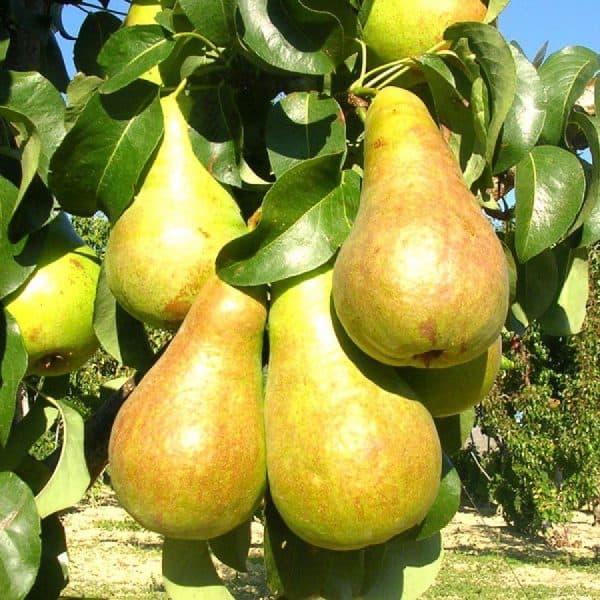

Late-ripening, autumn pears have an orange side, a skin, as it were, covered with oil, and the weight is 2 times less than early-ripening ones.
Very winter varieties reach 150-200 grams, the pulp is dense, but fragrant with a slight honey tint. They are also characterized by small specks on the skin.
Pears that ripen early are looser and not capable of long maturation, winter varieties are resilient, dry and sometimes stored until spring.
Gardeners identify several of the most popular varieties.
Decor
The Decora variety pear is small and belongs to semi-dwarf, its maximum height is 2.2 meters. In addition, the variety has the following specific characteristics:
- Unpretentious to the composition of the soil, resistant to infections and viruses, as well as frost-resistant.
- The pear begins to bear fruit 2 years after landing at the main site.
- Columnar pear fruits have a sweet-sour taste and are very juicy. They have been compared to the scent of a rose.
- The shape of the fruit is oval, its weight ranges from 200-230 grams. At the same time, the skin is rather thin, so the fruits do not belong to the maturing varieties.
- Color intense yellow.
It is important to note that this is a late-ripening variety, so it is not recommended to plant the tree in northern latitudes. There are other varieties of pears for Siberia that are recommended for cultivation.
Sapphire
Sapphire belongs to the varieties that ripen in the middle of autumn. Collecting pears begins in the first half of September and ends in early October, before the first frost.
- fruiting Saphira variety begins in the 3rd year after transplantation;
- fetal weight up to 200-250 grams;
- the form elongated, widening towards the bottom;
- color it is yellow with a green tint and medium-sized spots of dark brown color;
- frost resistance relatively good;
- also the tree has immunity to scab.
The gardeners determine the readiness of the fruit for collection by the appearance of a red blush on the pear.
Delight
Variety Vostorg is a relatively new variety of columnar pear, ideal for the middle lane, Moscow region. Breeders bred it with a relative frost resistance, but at the same time with a fast ripening stage.
Already at the end of July, the first fruits are harvested from the tree. Their taste is bright, juicy with a light honey tint and slight sourness. The fruit weighs about 150 grams and is elongated.
Carmen
Carmen, like Delight, belongs to the summer varieties. A characteristic feature of the variety is the burgundy color of the fruit, weighing up to 300 grams. Due to these qualities, the pear is incredibly popular among gardeners; whole orchards of 1.4-2000 copies are formed from trees.
To taste, the pear is classified as a dessert, the fruit is juicy, sugary-sweet with a thin skin. The first harvest ripens in early June, and the first fruiting after planting is possible in the second year.
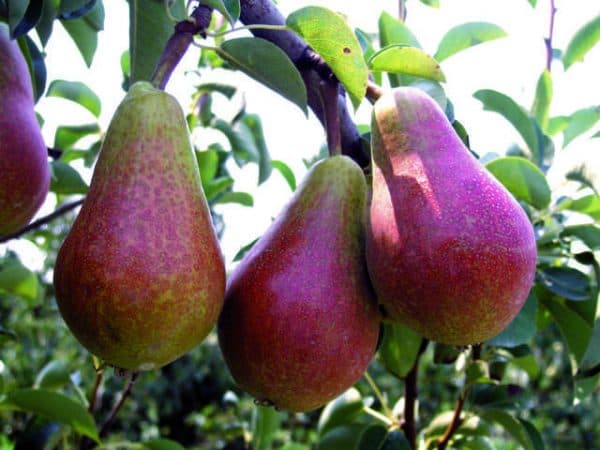

Carmen is also used for landscape design, since the pear has a bright and textured appearance, both during the fruiting period and during the flowering season.
Preparatory work
The columnar pear does not require much space, so you can always find a corner for it in the garden. It is advisable to prepare the landing pit in advance. For example, if the planting is done in the spring, then the hole is dug in the fall. This is done so that the applied fertilizers are fully "ripe" during the winter. In this state, they are more digestible for the root system of the tree. You need to introduce manure or compost, thoroughly mixing it with the soil. The bucket is enough for 5 holes. While the tree is young, it can be damaged by the wind. Therefore, it is better to plant columnar pears closer to any obstacle - near a fence, near a house or in another place protected from powerful winds. The distance between the pits can be made small, from 50 cm, and the row spacing from 1.5 meters. A good option is to leave up to a meter between trees in a row, so that in the future it will be convenient to handle them from pests and prune them.
Features of planting in open ground
An adult is much smaller than an ordinary garden dweller, and with mass seating they resemble columns, which is why such an unusual name went.
The fruits of the columnar pear are famous for their unique aroma and delicious taste, while they retain their properties for a long time. There are many types of such trees, but some varieties deserve special attention and respect.
Read also: Pear jam with slices: how to cook for the winter
We recommend to read: Zil-433362: technical characteristics, ko-713-01, brake system, diagram, reviews, price - Special equipment Info
Outwardly, such a garden culture looks very attractive, because of which it can fulfill not only a practical, but also a decorative role, being a valuable decoration for small areas. Let's consider all the features of a dwarf fruit tree in more detail.
The columnar pear is a relatively young hybrid that has been bred through diligent selection. Despite its small age, the variety is very popular and is of interest to a large circle of summer residents.
The tree boasts an unusual crown and a unique structure: small branches are tightly pressed against the trunk.
As for the fruits of the tree, they have a delicious honey taste and incomparable aroma.The culture has gained great recognition due to the lack of difficulties in self-planting and care. In addition, it freely takes root in harsh climatic conditions and is characterized by increased winter hardiness.
Planting and leaving
It is customary to plant a columnar pear in the autumn or spring. The maximum survival rate is observed when planting in the spring. If you plant a crop in the fall, it increases the likelihood of freezing of the roots, which are located close to the soil surface.
You should also pay attention to the fact that the best solution for planting are annuals, which have a fairly strong immunity. Biennial and perennial varieties are subject to various diseases and pests.
Planting activities begin with the preparation of the planting pit. There are no clear, established sizes, while they are determined by the width of the processes of the root system. When planting a whole row of columnar pears, a certain planting scheme should be observed so that between 1 and 1.5 meters of free distance remains between rows. With this arrangement, the culture will receive the right amount of sunlight and air, which is necessary for full development and reducing the risk of disease.
Before planting a seedling, it is better to pour at least 8-10 liters of water into the recess. If the water is normally absorbed, it must be mixed with three buckets of humus-sand mixture in a 2 to 1 ratio.
Potassium sulfate and superphosphate are added to the soil substrate, which will soon be covered with a hole. The planting hole is compacted, after which the seedling is lowered there. If the planting is done in accordance with the established rules, it remains to thoroughly water the crop. Further watering is carried out every three to four days. If the weather is too hot outside, you will have to water the tree daily.
Pruning features
Trimming measures determine the efficiency of fruiting and the growth rate. However, if at some stage irreparable mistakes were made, this can lead to the death of the tree. To avoid this kind of events, it is enough to perform trimming in two ways:
- shortening of young shoots;
- thinning branches.
Pruning can be done both in spring and fall.
As for spring pruning, it is better to do it in March or April, when the average air temperature becomes comfortable and the buds begin to swell. Columnar pears are known to be light-loving plants, so it is important that when pruning, an even distribution of heat is ensured in all areas.
Formative pruning is carried out on both young trees and adults in order to reduce the stress on thick branches during fruit ripening. In addition, pruning can also be a sanitary purpose when dry branches are removed to improve growth productivity.
Autumn activities are intended for sanitary purposes during a period when it is warm enough outside, but the leaves have already flown around. If you missed such a period and the temperature became too low, it is better to postpone the action until spring, otherwise the risk of freezing of the branches increases.
Young seedlings are pruned only during autumn planting a year later. If they were planted in the spring, then by the fall they are still underdeveloped, so pruning is not necessary.
Correct crown formation begins from the first year of life. For example, annuals are cut at a height of half a meter from soil level, while an accurate cut should be made on the kidney on the opposite side of the graft. Biennial plants need trimming the trunk of the center conductor.
After three years, the seedlings have 3-4 branches left.
When and how to plant
Planting of a columnar pear should be carried out in the spring, so that over the summer the young seedling has time to adapt, take root well and start growing. Then he will endure the winter cold more easily.In the fall, pears are also planted, but this is not the best option.
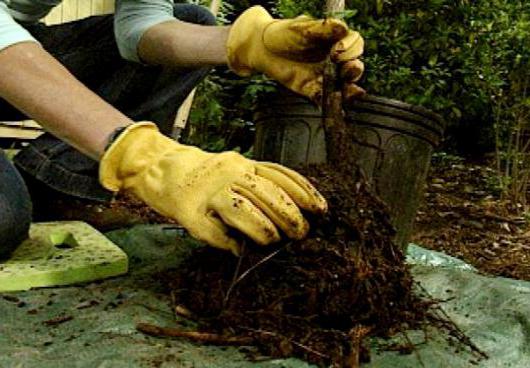

If you really had to, you need to do it before the beginning of October at the most. In the spring, planting begins after the ground warms up well. Each region has its own terms, but it is not recommended to plant columnar pears earlier than April and later than June.
The planting process is as follows. A bucket of water is poured into a hole prepared in advance, they wait until it is absorbed, a seedling is placed (the root collar does not deepen), the roots are straightened, sprinkled with soil (garden soil with 3: 1 sand and a little potassium superphosphate), compacted very carefully, the soil is added again and compacted again. This is done so that no air voids remain near the roots. At the end, near the trunk, they arrange a shallow hole so that water lingers in it, watered. It is advisable to tie the seedlings of columnar pears to a support (peg) so that the wind or some animal does not accidentally break the tree that has not yet matured.
Pros of pruning in the fall
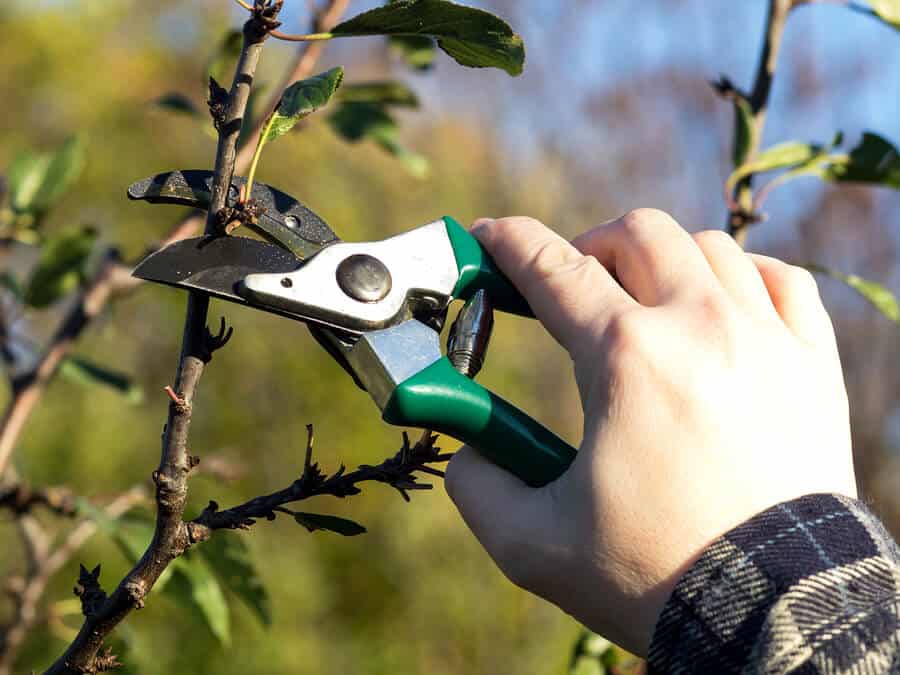

The benefits of autumn pruning include:
- Frequent change of weather in spring. According to the rules, the branches are removed before they awaken, but after the final establishment of heat. In the regions of the middle lane, suitable conditions persist for only a few days. Therefore, not all gardeners have time to meet the deadline. If it is hot and dry outside, pruning should not be done.
- A strong decrease in the yield of the fruit crop as a result of the removal of a large number of branches. Similar events in autumn do not reduce the number of ovaries. On the contrary, the yield increases due to the abundant formation of young shoots and an increase in the size of the fruit.
- Small trauma of autumn pruning for trees. Sap flow at this time slows down. The plant does not need to spend energy on fruiting and pest control, since their activity is reduced.
Pear pruning in the fall begins immediately after harvesting. Depending on the climate of the growing region and the varietal characteristics of the crop, this period extends from August to October. Early varieties and varieties with low frost resistance are cut first, since they need more time to recover. Trees with high winter hardiness are cut at the end of October.
Important!
The pruning work is finished no later than 2 weeks before the onset of frost. In the Central lane, the Moscow region and the Leningrad region, it is completed by October 10. In Siberia and the Urals, the pear is pruned until mid-September. With the early onset of night frosts, the formation of the crown of varieties with low frost resistance is transferred to spring.
Care after landing
Columnar pears are somewhat easier to care for than regular pears. In the first weeks after planting, the seedlings should be watered as the water in the near-stem hole dries completely. The correct solution is to mulch the earth in the near-stem hole. Further, watering is reduced to 1 time in 2-3 days. In order for the seedlings to take root well, caring for them includes cutting off all the inflorescences that appear in the year of planting.
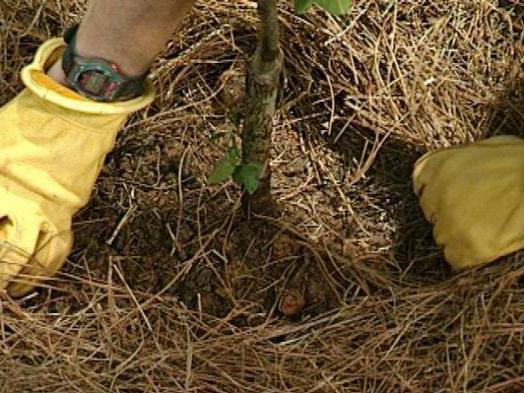

Some gardeners advise pinching the top of the seedling in the first year. This is also done in order to give the tree the opportunity to use all its forces for the development and survival of the root system. In autumn, it is advisable to tie the trunk of a young tree about 40-50 cm from the ground with some kind of insulation. Firstly, in severe frosts, this will prevent it from freezing, and secondly, the insulation will serve as protection against damage to the bark by animals, if they suddenly wander into the garden that was left unattended in winter.
Preparing for winter
Preparation for winter begins at the moment when the entire crop is harvested, and all the leaves have fallen from the trunk and branches. Fallen leaves are collected with garbage and burned.
If this is not done, then you can create an excellent breeding ground for pests, usually hibernating in humus.
The weak point of columnar pears is the top. In the first 2-4 years, it is very delicate and needs to be covered with a cloth that protects from frost, but at the same time allows air to pass through.


From below, the pear is tied with spruce branches and sprinkled with snow, thereby protecting it from rodents and hares.
Further care
Basically, columnar pears require about the same care as all other fruit trees. It consists in periodic watering, especially during the period of setting and ripening of fruits. During these months, trees should be watered every three days, each time trying to completely fill the hole around the trunk with moisture. Fertilizers are desirable to be applied every year. In spring it can be mineral fertilizing, and in autumn compost, humus, "ripe" manure. In order to get a good harvest, it is necessary to regulate the number of ovaries. To do this, only two flowers are left in each inflorescence rosette. The others cut off. In early spring, while the buds are sleeping, they prune columnar pears. Lateral branches are removed completely or up to the second bud, skeletal ones are left. It is impossible to chop trees strongly in pursuit of fruits, because with the help of foliage they breathe and produce metabolic processes. In addition, after active pruning, columnar pears throw out many new shoots. If the apical bud has given several shoots, the most powerful one is chosen, the rest are removed.
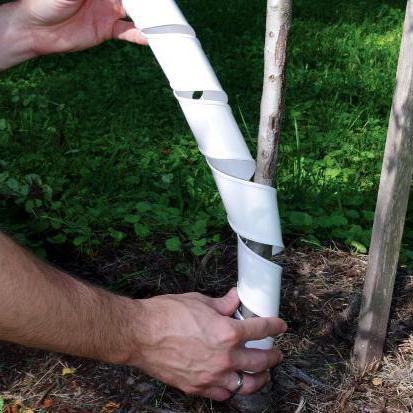

Pear pruning seasons
By the time of pruning a columnar pear, gardeners have different approaches.
Spring
Most gardeners are convinced that the best time to prune this variety, like other pear varieties, is spring. This is due to the fact that during this period there is a flow of juice reduced in activity. As a result, it is easier for the plant to endure the pruning procedure.
Pruning of a columnar pear in the spring is carried out if the air temperature is established, its decrease is not expected.
Spring pruning in regions with a warm climate is carried out in March, with a cooler one - not earlier than the first days of April.
Few dare to prune fruit crops in summer. Most gardeners do not recommend this event in the summer, because along with the cut branches, the grown foliage, which participates in the process of photosynthesis and is responsible for the nutrition of the plant, is also removed.
It is better to cut such a pear in summer in June, when there is an active growth and development of shoots.
Fall
Pruning of a columnar pear in the fall is performed as a sanitary measure; it includes the removal of damaged branches, through which juice no longer circulates and food is not delivered. At the same time, shoots are cut off that do not produce fruit, but take away the strength from the plant.
It is recommended to prune columnar varieties in the fall at the beginning of the season, before the cold has yet come.
Pear diseases, non-infectious
Columnar pears are believed to be disease resistant. This is partly true, and yet dwarf plants can attack the same insects that harm ordinary trees. Especially dangerous for pears is the proximity of apple trees, since their pests are approximately the same. These are hawthorn, gall midge, pear moth, leaf rollers, ticks, weevils, scale insects, aphids. Some of them destroy the leaves, others spoil the fruit. In any case, the tree begins to ache, its vitality decreases.
The fight against insects begins in the fall, in the very first year of planting a columnar pear. It consists in cleaning all the leaves under the tree, examining the branches and removing from them all not fallen, dry, twisted, blackened leaves. It is very useful to loosen the soil near the trunk so that the eggs and larvae left there by pests die. But this must be done very carefully, since the columnar pear has a superficial root system that is easily damaged. For preventive purposes, trees are sprayed with urea in autumn (diluted according to instructions) or top dressing with the same drug.The next spraying should be in early spring on unopened buds. In addition, pears get sick due to improper care, which consists in excessive waterlogging or, conversely, dehydration of the soil, from a lack of minerals (without dressing).
How to care for a columnar pear?
If we compare the care of apple trees and pears, then it is almost the same, the only and main rule is to prevent drying out. In spring and autumn, watering a columnar pear is done every 3-4 days, and on hot summer days it is watered every 2 days. To retain moisture in the soil, mulch is used, which is used to cover the ground; for its preparation, peat, straw and sawdust can be mixed. In the first year, even if there was good care of the columnar pear, it will not give a crop, despite the appearance of inflorescences. In addition, it is necessary to remove all the flowers in the first year so that the tree gives more strength not to the fruits, but to its root system.
If the planting and growing of the pear was correct, then in the second year the flowers can be left and the tree will give the first few pears. Every year their number will increase, and the fruiting itself takes an average of 15-17 years. After that, the tree grows old and practically does not yield a harvest. Some hobby gardeners do not know how to care for a tree so that it produces many large fruits. Everything is very simple. Periodically, the pear needs to be fed with fertilizers, this work is done in spring and summer, somewhere in mid-July. As a top dressing, you can use humus, chicken droppings, urea or saltpeter. It is also very important to periodically treat the bark of a tree with solutions from diseases and pests. For the winter, the lower part of the trunk is sheltered from frost.
How to propagate a pear?
If you look at the photos from the network, you will notice that there are columnar pears of different colors, but the shape of the tree and the height are almost the same. The most common method for breeding this type of pear is the stock, therefore, ready-made, formed trees are often planted. Some people don't even think about whether there are other methods for growing seedlings. Of course, they exist - these are seeds and the method of cuttings. Among the two options, the most successful and fastest is the second method, since seed reproduction requires a lot of effort, time and expense.
In order to propagate a columnar pear by cuttings, green branches are required, which should have more than five leaves. After cutting, they are treated with a special rooting compound, and then sprinkled with earth. If the branch has taken root, then its shoots will grow rapidly and form a good root system over time.
The most popular and easy way to propagate a pear is grafting. In this case, the tree turns out to be quite strong and developed, it grows very quickly and bears fruit already in the second year after grafting. An ordinary pear is used as a stock, but other fruit trees are also suitable. It is important to know that some varieties of pears, for example, Delight 2, are self-fertile or self-fertile. Therefore, if these varieties grow side by side, then it is necessary to plant pollinators between them, which will make fruiting correct. As pollinators, apple trees, common pear varieties, or other fruit trees are suitable.
Each variety of columnar pear has a delicate aroma and special taste. The crop is stored for a long time, and the tree is not afraid of frost, but the lower part of it is sheltered for the winter. Therefore, if a tree is well cared for, it will give its owner a rich harvest. In addition to their main purpose, such dwarf pears become a wonderful green hedge with fruits and will decorate the design of every garden.
Columnar Pear Problems
Pear is a unique, rare culture that pleases its owners with a generous harvest and pleasant, sweet taste.And if you plant different varieties of this tree, you can eat its fruits from summer to spring, as they are perfectly stored. However, there are such moments during cultivation, when the fruits for some reason do not form, despite the abundant flowering and good weather. So why is this happening and what to do about it?
Among gardeners, there is a problem when a pear does not bear fruit, this happens for many reasons, here are the most basic ones.
- Not enough light. This is the most common reason if pears do not bear fruit and are not set in color. The only solution to this problem is to transplant the tree to a bright, sunny place.
- Lack of pollinators. If there are several pears of the same variety on the site, then pollinators are needed between them, which are planted next to the tree. The most ideal option is the presence of several varieties of pears at once, which will be pollinated among themselves. If desired, ordinary cherry plum pears are suitable for these purposes, which must be planted between columnar varieties.
- Lean soil. To get a good harvest, the tree needs to be provided with enough nutrients. In addition, its root system goes quite deep, so feeding the pear is a necessity. Fertilizers are applied every two weeks, watering the tree.
- Incorrect feeding. Some people think that there is not a lot of fertilizers - this is a myth or reality, let's try to figure it out. Not everyone knows that the pear blooms profusely from an excess of nitrogen fertilizers, but it does not tie the fruit. Therefore, everything should be in moderation and according to the instructions. In spring and early summer, nitrogen fertilizers are used, and from mid-summer and autumn - complex fertilizers.
- Bad stock. There are types of pears that bear fruit at 7-8 years old and even later, since the wrong rootstock was used. Therefore, it is better to choose a stump from dwarf trees, for example, quince. As a result, the first fruits will appear earlier and will be large.
- Incorrect fit. You cannot deeply deepen the seedling during planting, otherwise fruiting may not occur, what to do in this situation? This nuance is connected with the fact that the root collar is decaying and can quickly rot.
- Apple blossom beetle. An insect with this name leads to the fact that the columnar pear is left without a crop. You can eliminate this pest using a solution with Aktelik or Fufanon. You can also cover the tree with a fine netting during flowering or set special traps, since this beetle flies, but mostly it crawls on the ground.
- Strong pruning. It so happens that the columnar pear does not grow and does not bear fruit. This may be due to aggressive pruning and should be kept to a minimum, especially on mature trees.
Infectious diseases
If the diseases of pears listed above are simply unpleasant, because they spoil the appearance of the tree and reduce the yield, then infectious ailments can completely destroy the plant. The most dangerous pear diseases are bacterial burns and bacterial cancer. Their pathogens are bacteria, which are very difficult to fight. In addition to them, there is also scab, fruit rot, septoria and leaf spot caused by fungi. In order to prevent these diseases, it is necessary to take a responsible approach to the autumn work on cleaning the garden and feeding. Of great benefit in the fight against fungal diseases is the autumn whitewashing of the trunks with lime, in the solution of which you can add copper or iron vitriol (the seedlings are treated with chalk). In order to avoid the appearance of bacterial diseases, mechanical damage to the roots and aerial parts of pears should not be allowed. When trimming the wound, you need to cover it with garden varnish or any oil paint on drying oil.


Carmen
Pear Carmen - the result of hybridization of varieties Williams red and Daughter Blankova. Originator - Stanislav Yakovlev. The variety is characterized by low frost resistance, late early maturity and medium fruiting.However, this culture is undemanding in terms of planting and maintenance, takes root on any soil and is resistant to scab.
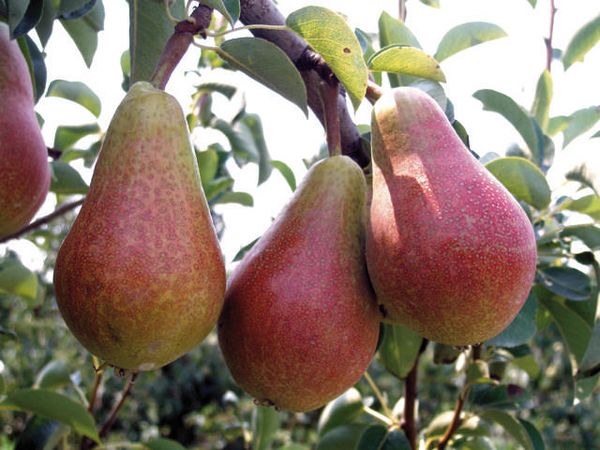

During the ripening period, the fruits of the Carmen variety have a beautiful burgundy-red skin tone. The shape is correct and homogeneous. The fruit tastes sweet with a slight sourness, there is no astringency feeling.
Reproduction
Of course, it is better to buy ready-made seedlings. But sometimes you want to get a variety that is not on sale. It is believed that the columnar pear reproduces by seeds and cuttings. With seed reproduction of fruits, you can wait a very long time, and the grown seedling needs a stock. Certain types of ordinary pears do reproduce by cuttings. You can also try to multiply the columnar. The cuttings are used green (summer). They are cut so that they have 3-4 sheets and at least two internodes. Cuttings are carried out in greenhouses in the ground, which is a layer of sand (4 cm) on a layer of sphagnum moss (up to 4 cm). Before planting, the cuttings are kept in a root former for 24 hours. If the cutting takes root, it grows very quickly. But best of all, a columnar pear reproduces by grafting. Reviews of gardeners note the rapid growth of established branches, their good yield. An ordinary pear or irga can act as a stock.
Growing features
The root system of columnar pears develops in a horizontal plane and is located near the surface.
Due to the peculiarity of the structure, trees are planted in spring, thereby minimizing the risks of extinction and the adaptation period. The soil for seedlings is prepared 2-3 weeks before the expected date:
- a hole is being pulled about half a meter deep and about 60 cm in diameter;
- distance between rows - 1 meter.
Soil and pit preparation
The soil for the planting pit consists of:
- humus;
- compost;
- natural land;
- organic fertilizers.
On average, 3-4 kg of soil and 1 bucket of settled water are calculated for 1 tree.
Distance between trees
Despite the fact that columnar pears do not have lateral processes and are compact in size, gardeners recommend maintaining certain distances between trees. The row spacing must be at least 1-1.25 m; distance in a row - from 40 to 50 cm.
Smaller sizes can lead to a lack of air and light, which will directly affect the amount of the crop, as well as the spread of diseases.
In close proximity, scab can be transmitted from one tree to another with lightning speed.
Features of the root system
As noted above, the root system of the columnar pear is poorly developed, the processes spread horizontally, without going deep into the ground. On the one hand, this is a plus for adaptation, since the top layer has more nutrients and is warmer.
On the other hand, the superficial root system does not tolerate frosts well and adapts worse when planted in the autumn.
Sapling selection
In order to have a healthy garden with a bountiful harvest, gardeners adhere to several rules when choosing planting material:
- Trees take one year old or two year old.
- The seedling must have all the necessary documents, as well as recommendations for care.
- Healthy pear possesses green juicy bark and leaves.
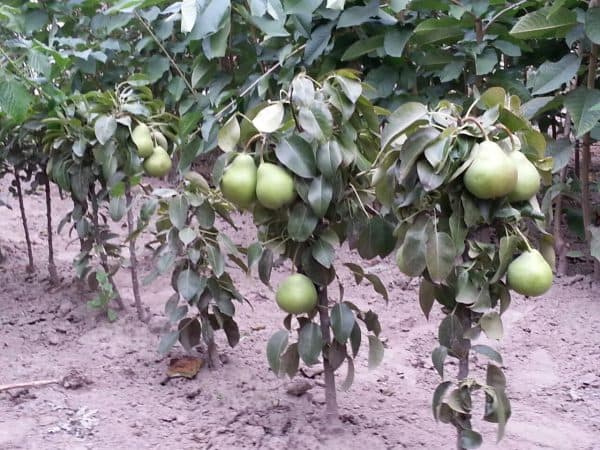

Older seedlings can carry various infectious diseases.
Landing rules
After the soil is prepared, a hole is dug, they begin to plant. The pit is moistened abundantly with water and allowed to soak. Then a seedling is placed vertically, with a straightened root system.
In order for the root system to expand as much as possible and not gather in the process of burying, pegs are driven in between them.
They try to leave the grafting site above the ground, and cover the entire root system.
The soil is covered in two stages:
- filling half of the pit;
- neat tamping;
- leftover land.
After the end of the procedure, the seedling is watered again and the soil is poured into the failed areas.
Varieties
In recent years, the columnar pear has become popular with selectors. The varieties, of which there are quite a few, differ in terms of ripening and taste of fruits. They are designated by a number and a common letter "G".
- G1 - winter, yellow fruits, weighing 0.25 kg each.
- G2 - late autumn, fruits are green, with red strokes, weighing 0.2 kg.
- G3 - early autumn, fruits are large, bright yellow with oily skin, weighing up to 0.4 kg.
- G4 - autumn, fruits - up to 0.3 kg each.
- G5 - summer-autumn, yellow fruits with red strokes, weighing up to 0.25 kg.
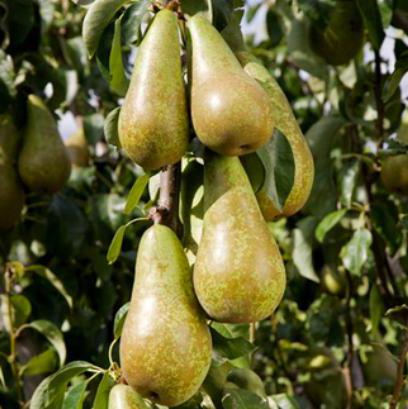

Varieties for the Moscow region and the middle lane
The best varieties of fruit crops, according to experts, do not require intensive care, and also successfully combine a decent yield, stability and can serve as a good element for the decor of the backyard territory. Columnar pears can be winter, early ripe, autumn, summer-autumn and late autumn.


| Variety | Description of the variety | Fetus | Pulp |
| "Tenderness" | High-yielding winter-hardy variety, forming harvest by September | Large size, yellow-green color with a slight tan | Delicious, very juicy and tender |
| "Sapphire" | Autumn ripening period, with sufficient resistance to scab and low-temperature conditions | Elongated, pear-shaped, greenish-yellow in color with small rusty specks, recumbent | Very good tasting, tender and sweet, relatively aromatic |
| "Honey" | A productive variety with excellent taste, winter-hardy and resistant to major diseases | Short pear-shaped with tuberosity on the surface with slight ribbing, weighing in the range of 280-530 grams | Sufficiently juicy and very sweet, has a slight sourness and an exceptionally pleasant taste |
| "Decor" | Forms a low self-fertile plant, no more than 1.9-2.2 m in height | Large, weighing up to 230 g, round-oval, green-dark yellow, without blush | White, juicy and very tender, with a good aroma, sweet, with a light and pleasant aroma |
| Dalikor | Winter French variety, ripening in the first decade of October and perfectly stored until February | Large, yellow-greenish, with a slight rusting on the sides and a blurry light blush | The pulp is juicy, cream colored, very tender, without granulation |
| "Sunremy" | Medium late ripening, unpretentious and disease resistant. | Large sizes, marketable appearance, weighing 350g and more. | With very good taste, tender, sweet, aromatic. |
| "Night-Werth" | A fast-growing variety of foreign selection with good resistance to low-temperature conditions | Attractive, with a smooth glossy surface, greenish-yellow base color, weighing 200 g | Good taste, very juicy, melting, sweet taste with a pleasant aftertaste. |
| "Autumn Dream" | Low-yield and fairly high-yielding autumn variety, ripening in September | Small size, green-yellow color | White, juicy, semi-oily type, sweet and sour taste |
| "Favorite of Yakovlev" | Winter-hardy large-fruited and partially self-fertile variety | Large sizes with an attractive appearance, for fresh consumption | Sweet and sour taste, juicy, creamy color with pronounced graininess |
| "Carmen" | Early disease-resistant summer pear with marketable fruit | Saturated burgundy color, uniform shape, weighing up to 250-270 g | Off-white or off-white, melting, sweet taste |
Gardeners' recommendations
Experienced gardeners, when pruning pears in the fall, recommend that beginners adhere to the following rules:
- Careful preparation is the key to success. It is necessary to inspect the trees in advance and plan the sequence of work.
- There are no exact dates for pruning. You always need to be guided by the weather and climate in the region.
- A good tool is the foundation of a healthy garden. A high-quality sharp instrument inflicts much less damage, which heals faster.
- Safety comes first. When working with the tool, all safety rules must be observed, especially when working with the upper tier of the crown.
- Compliance with the principle of subordination. The branches of the lower tier should not be higher than the branches of the higher one.
- It is always better to prune one thick branch rather than several smaller ones.
- All work must be started from the upper tier of the crown.
- Trimming tops on a pear can be done not only in the fall, but also throughout the season.
Are compact pears real
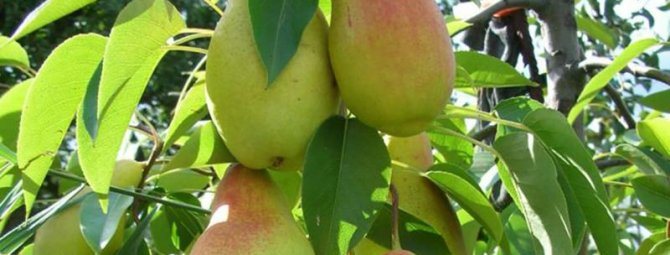

The owners of small plots of land and summer residents, after the appearance of columnar apple trees in the culture in recent years, enthusiastically took up the cultivation of columnar pears and other fruit trees with a crown of this shape. Amazing! They grow what is not in nature. In addition to columnar apple trees, there are no fruit trees that would have a columnar shape and retain it throughout their life. There are dwarf forms, undersized, bushy, but all of them in the second or third year of growth have a rather wide crown, completely different from the columnar one. It is difficult to say which plant is offered by the distributors of the planting material, announcing the seedling as columnar.
General information
Having decided to plant a pear presented as a columnar one on your site in the Moscow Region, you should not miss the moments of choosing a seedling, common to all horticultural crops: frost resistance, disease resistance, yield. In addition, it is no secret that the climate in the south of the Moscow region is somewhat milder than in its northern parts. So, speaking about "columnar" pears for the Moscow region, you can give only general information, and only the gardener will have to make a decision, taking into account the peculiarities of the area where the tree will grow.
In addition, both tall pears and undersized or dwarf fruit trees of this species are distinguished depending on the ripening time of the fruits:
- summer;
- autumn;
- late autumn, which are also called winter.
Pear announced as columnar on video
As you can see even in this short video, the tree is ordinary, spreading, fruits on horizontal branches, like a traditional tall pear. Perhaps the tree is undersized or on a dwarf rootstock. A similar observation can be made by carefully examining the photographs accompanying the descriptions of "columnar" pears.
Below are descriptions of such pears recommended for the Moscow region, compiled on the basis of information from the Internet, with a mention of the care features indicated for a particular variety.
Summer
Pears, the fruits of which ripen in the summer months and can be grown in the Moscow region, include Severyanka, Carmen, Decor, Tenderness.
Severyanka
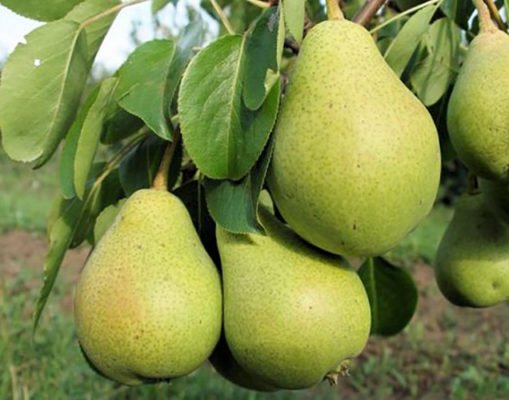

Severyanka trees, low up to two meters, are very frost-resistant
Severyanka trees, low up to two meters, are very frost-resistant. After planting, the first harvest is given for 5-6 years. Juicy and aromatic fruits begin to ripen in mid-August, sometimes even in the first decade in good weather. They have a green peel with a yellowish tinge and a dark blush. They taste sour-sweet, weighing from 70 to 100 grams, rarely more. Pears can be stored for up to one and a half weeks. Severyanka is suitable for home canning. The disadvantage of the variety is its susceptibility to scab disease.
In the description given in the State Register, it is indicated that the Severyanka variety has fruits whose size is below average, and the average weight is 80 grams. The rest of the varieties are not included in the State Register.
Carmen


The bright burgundy color of pears makes these trees very decorative.
The burgundy color of the fruit, unusual for pears, makes these trees very decorative. Their height reaches 2.5 meters, the crown is compact, no more than half a meter in diameter. The first harvest after planting the tree can be enjoyed in the third year.Pears ripen in the summer in mid-August and weigh about 250-300 grams each. The removed fruit can be stored for up to 15 days. The tree is resistant to scab and septoria. Carmen prefers fertile soil and does not like excessive and stagnant moisture.
Decor
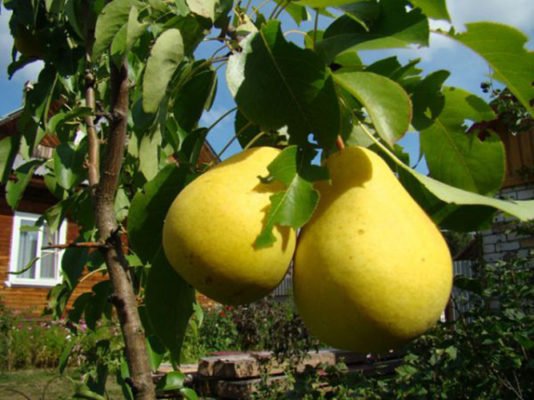

Decor is a late summer variety, pears ripen by the end of August
Decor is a late summer variety, pears ripen by the end of August. The tree grows from one and a half to two meters in height. After planting, the pear begins to bear fruit for 2-3 years. Straw yellow fruits weighing from 200 to 400 grams have a juicy slightly sour pulp, slightly smelling of a rose. Ripe fruit can be stored for one and a half to two weeks. The variety has significant resistance to cold weather and diseases inherent in pears.
Tenderness
These compact trees, no more than two meters high, can withstand frosts of forty degrees.
A pear with the romantic name Tenderness is well known to gardeners and summer residents from Kaluga to Chelyabinsk. These compact trees no more than two meters high can withstand frosts of forty degrees and are not afraid of fungal diseases. From the third year of pear growth on the site, it gives a high yield every year. Fruits are small, up to 200 grams in weight, covered with a light green peel, which turns slightly red in the sun. The pulp of the fruit is sweet and sour, juicy and aromatic. Ripening time - late August or early September, depending on the weather of the season. You can store the crop for no more than a month. During the dry season, Tenderness needs additional watering. Pears are used fresh, baked and processed.
Autumn
The group of pears that ripen and are consumed in the fall and can be grown in the Moscow region include such as Saphira and Sanremi.
Sapphire
Sapphire - a winter-hardy pear with a height of 1.8-2 meters
Sapphire is a winter-hardy pear with a height of 1.8–2 meters, which is not afraid of most diseases. She will give the first harvest in the third year after planting. The fruits ripen at the end of September. Their weight is 180-230 grams. When ripe, pears are greenish-yellow in color with a burgundy blush in the place of sunlight. Juicy pulp is slightly oily. Pears have a sour-sweet taste and are very aromatic. They do not fall from the tree even in heavy rains. The fruits removed from the tree are left to settle down for two weeks, then they can be eaten, and Sapphire pears can be stored until December.
Sanremi variety
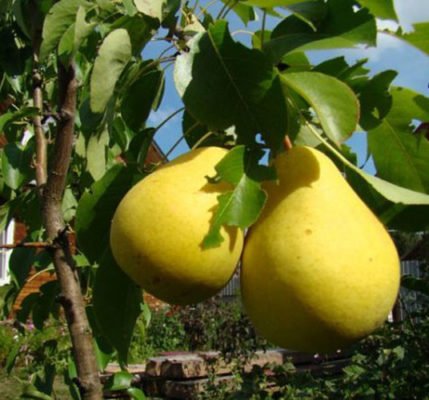

Sunremy is a self-pollinating winter-hardy pear variety that ripens in early October
Sunremy is a self-pollinating, winter-hardy pear variety that ripens in early October. Trees grow up to two meters high. They are not susceptible to clasterosporosis, moniliosis and most other diseases. The first crop can be harvested in the third year of the seedling's life on the site. Fruiting is annual. The harvest ripens in early October. Large pears weighing up to 400 grams, greenish-yellow. Juicy, tender and aromatic pulp has a sweet taste, which is estimated at 4.9 points. The crop is stored for no more than two months. Pears tolerate transportation well. They can be eaten fresh or made into homemade preparations in the form of jam, juice, compote, jam, and so on.
"Winter" pears
Harvesting in late autumn, these trees are attractive to gardeners because their fruits can be stored for a long time, which allows you to feel the aroma and flavor of summer in the cold winter months. An example of such pears is the Dalikor variety, bred in France, but successfully grown in our country.
Dalikor
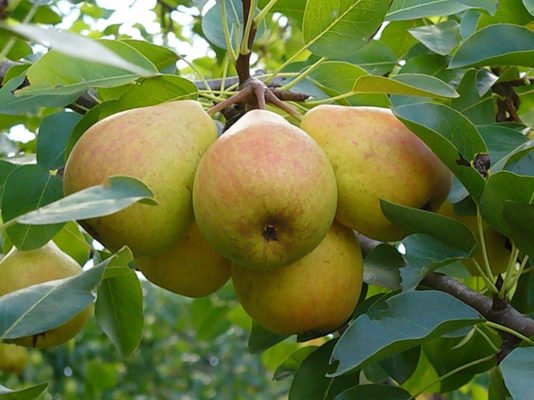

The fruits ripen in early October and can be stored until February.
Dwarf trees up to one and a half meters high. The fruits ripen in early October and can be stored until February. The fruits are yellow with a blush and have a very juicy creamy flesh. The yield is good. The care is minimal - top dressing and moderate watering without waterlogging the soil, does not need pruning, but in the spring it is necessarily treated with complex fungicides, since it is easily infected with scab.
Whether to plant a "columnar" pear
Some resources on the Internet indicate as the creator of columnar pears of the famous breeder of columnar apple trees, candidate of agricultural sciences Mikhail Vitalievich Kachalkin, although he completely denies even the existence of such plants.
Columnar pears, plums and apricots. Myth or Reality?
Are there columnar pears?
If, contrary to all that has been said, the gardener decides to plant a "columnar" pear on his site, he should pay attention to the general recommendations for planting and caring for this type of tree. It may be worth checking with the seller the nature of the rootstock and taking into account the possible nuances of growing the plant.
In fact, it is not difficult to form a pear with a compact crown, the height of which will not exceed two meters, and the width will be about 1.2 meters. Such trees are successfully grown for production purposes. This form of the crown is called dwarf pyramidal. True, caring for such a pear will be somewhat more intense than for a tall one, since you will need:
- summer pruning;
- removal of powerful vertical shoots;
- timely collection of fruits.
It is possible to form such a crown of a tree if a varietal pear stalk was grafted onto a cherry plum. Such a rootstock successfully maintains a balance between the renewal of fruit formations and constant fruiting.
Saplings are planted during the dormant period in spring or autumn. For a single tree, stakes are installed to tie a young plant. If a number of young trees are planted, a trellis with wires stretched at a height of 0.45 and 0.9 meters is made to tie them up. A distance of 1.5-1.8 meters is left between trees, about 2 meters on fertile soils. The row spacing is 2 meters.
The formation of the crown begins immediately after the pear is planted in a permanent place. On the trunk of the tree, a bud is determined at a height of about half a meter from the ground, located on the side opposite to the grafting site. A cut is made above this bud, which is treated with garden var. During the summer, 4–5 shoots will form no more pear.
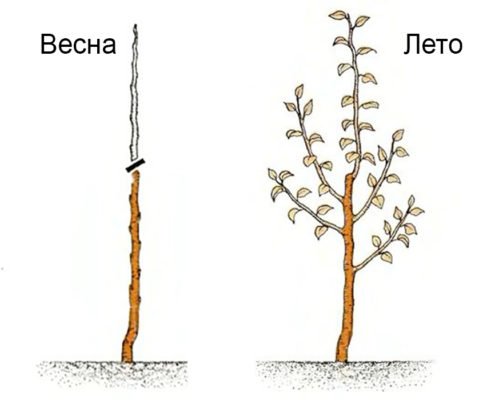

The formation of a dwarf pyramidal crown of a pear begins in the first year of planting the tree
In the spring of the following year, the vertical shoot is pruned, leaving about 0.25 meters of its length, above the bud located on the side that is opposite to the previous pruning. This pruning stimulates the growth of new side shoots.
The lateral shoots that have grown last year are also cut to the bud, which is directed downward and is located at a distance of 0.2 meters from the trunk.
In the summer of the same year, lateral shoots are shortened, which are not needed to create skeletal branches, leaving only 7-10 centimeters of growth, that is, no more than three leaves. Shoots of the second order, that is, those extending from the branches that grew last year, are cut off, leaving 1 leaf. The guide (central vertical shoot) is not pruned.
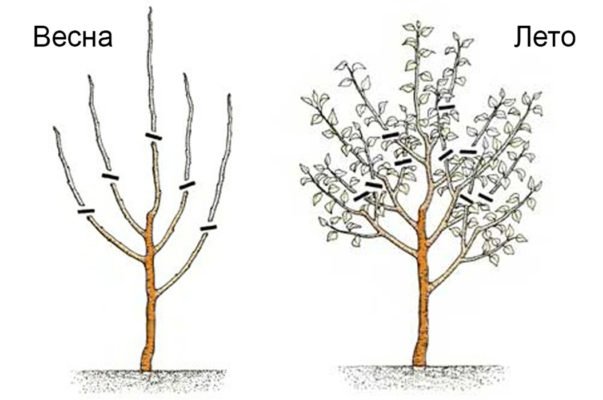

Formation of the crown of a young pear in the second year
In the third and subsequent years, the conductor is cut off, leaving 0.25 meters of its length, as in the previous year. The growth that has formed as a result of last year's summer pruning is cut over a well-formed bud. All powerful vertical shoots are removed completely.
In summer, all lateral shoots are shortened to three leaves, shoots of the second order - to one leaf, shoots continuing skeletal branches - to six leaves.
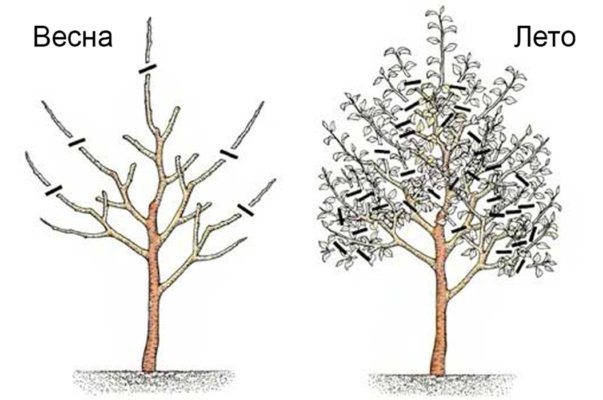

The third year of the formation of the crown of a pear tree
On an adult tree that has reached two meters in height, in the summer, the central guide is shortened for the entire length of the growth of the current year. Also cut off strong shoots directed upwards and lateral branches that have grown beyond the crown and interfering with neighboring pears, thin out the fruit.
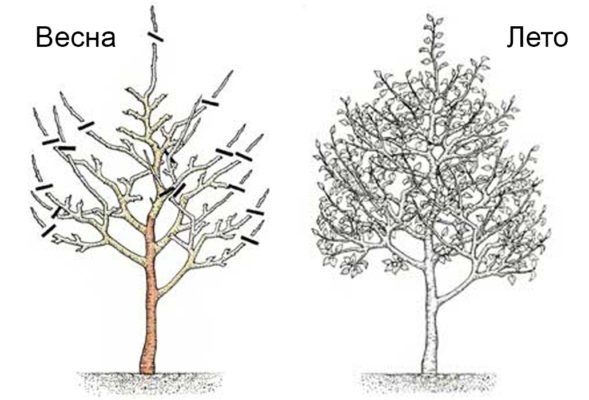

Maintaining the shape of the crown. Pruning a mature tree
The crown formed in this way will occupy an area of slightly more than one square meter, which, of course, is more than the area allotted for a columnar tree, but it is quite acceptable even for small garden plots.
Reviews of columnar fruit trees
As for the columnar apple trees (and this is perhaps the only columnar fruit plant), the chief expert in these matters is Mr. Kachalkin.
There are several subtleties. The seedling of the columnar variety must be on a real dwarf rootstock.With all the ensuing consequences (both pros and cons, such as the need for irrigation and intensive nutrition). They begin to bear fruit practically in the year of planting (according to the descriptions and if properly grown), the effect is economic with a very dense planting. Many columnar varieties freeze slightly in the Moscow region and to the north.
For me, there is no particular sense in them. It's easier to graft ANY frost-resistant and favorite variety on a super dwarf (like Kid Budagovsky) and get everything the same, just more reliable and much more varied in terms of varieties. The tree will be about 120-150cm maximum and will begin to bear fruit the next year after planting, it is better not to allow the hoe, otherwise the bonsai will be completely. It is better to grow first to the top to the maximum, and then get the fruits.
Andrey Vasiliev
When damaged by frost, the columns turn into a "brush", under all ideal conditions - to feed, water, blow off dust particles - the yield is very small, 5–6 kg per tree, there is information that fertility greatly decreases after 12–15 years. The price of a seedling with us is 500-600 rubles per piece. It seems to me that all this hype around the columns is needed only by the manufacturer. Isn't it better to plant ordinary trees, now there is a huge selection of beautiful, delicious varieties that will bring joy to you, your children and grandchildren?
Marina-Ufa
Regarding the cultivation of "columnar" pears in his area, each gardener can only make a decision for himself, based on the information available to the public.
Susceptibility to diseases and pests


- if you see diseased bark, then brush it off. If the tree is sick with black cancer, then black rot will appear on the fruit;
- If you see brownish spots on the leaves and stems, this means that the tree is sick with scab. In the fall, collect all the leaves and burn. Sprinkle trees with Bordeaux mixture in the spring;
- in the absence of ovaries and the appearance of white powdery powder on the leaves, and then they fall off, you will understand that the trees are sick with powdery mildew. Cut off diseased shoots in the fall and burn them. And you can process the tree itself in early spring even before budding with Ditan M-45, Tiovit Jet;
- if red spots appear on the leaves, it means that the pear is sick with rust. To eliminate rust, tear off and burn diseased leaves and fruits, and treat the trees with Bordeaux mixture (1%).
- trees can be attacked by aphids, honeydew, tick, leafworm, moth, fruit gall midge. The safest way to get rid of harmful insects is by spraying the trees with bioinsecticides. The drug Bitoxibacillin, made on the basis of bacteria, is very popular among summer residents;
- for spraying, prepare a suspension according to the instructions, dilute 40-80 g of the drug in a ten-liter bucket of water. To make the drug stick better to the leaves and stems, add 2 tbsp. tablespoons of milk powder per 10 liters of solution, or pour half a liter of skim milk into 10 liters of suspension.
Spray trees in the evening when there is no rain, and the air temperature is not lower than + 13 ° C. The drug does not harm beneficial insects - wasps, bees, bumblebees. To prevent harmful insects from attacking trees, you can plant dill, tobacco, marigolds near them.
Is it possible to prune a pear in the fall
Many gardeners avoid autumn pruning, arguing that this procedure reduces the winter hardiness of trees. This is indeed the case. Therefore, in the fall, young pears are not pruned, as well as varieties with poor winter hardiness. Otherwise, the spring and autumn pruning is identical, both are carried out during the period while the tree is dormant.
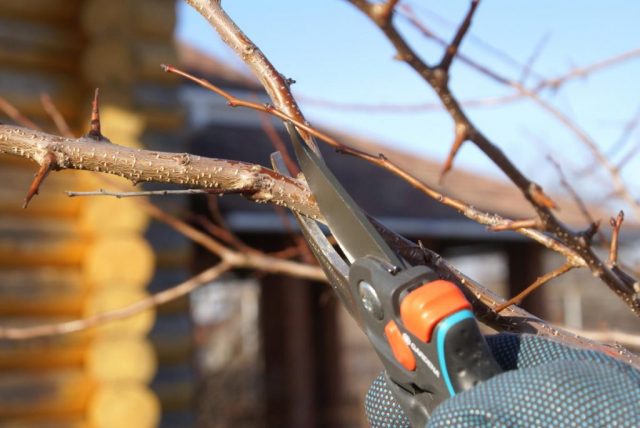

In autumn, it is more advisable to prune mature trees, since there is no danger of missing the deadline, and the whole procedure can be carried out without haste. Weather conditions at this time, as a rule, are much better than spring ones, at this time there is no dirt underfoot, and the air temperature is more comfortable.
PEAR COLUMNS AND Dwarfs
Increasingly, columnar apple trees are widely advertised in the markets for planting material.In colorful pictures, trees, like sticks, of small stature, densely covered with large beautiful fruits; the salespeople’s impressive stories are so convincing that crowds of buyers are buying far from cheap “supernew” varieties of columnar apple trees.
The most interesting thing is that columnar pears also offer, which simply do not exist in nature. Online stores and advertisements in various print media are literally full of elegant pictures with the image of a "miracle stick" hung with elegant pear fruits. Considering such photos and succumbing to the seller's fairy tales, people quickly buy up imaginary new items.
What's the bottom line? Or the "miracle tree" turns out to be the most common, and under the guise of a wonderful "column" you were handed a long-known tall variety - perhaps not even intended for cultivation in your region.
Autumn dream
Autumn Dream is a hybrid variety bred by crossing Decan and Koperechka pears No. 10. The plant is zoned in the Central Black Earth economic region. But the plant did not become widespread due to the external unattractiveness of the fruits. Fruit - small and heterogeneous, abundantly strewn with "rust". Used for processing into compotes, juices, fruit drinks, preserves and jams.
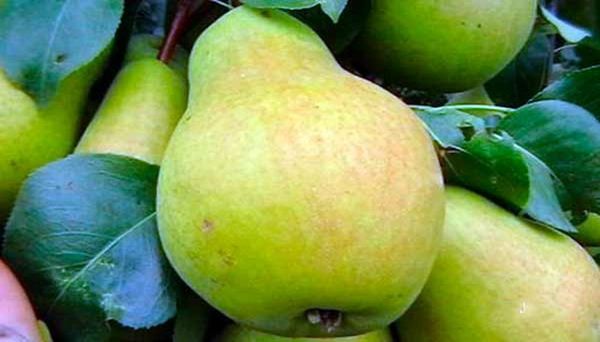

Harvesting falls in the last month of summer. Fruits are stored until November, with longer storage they begin to fade.


